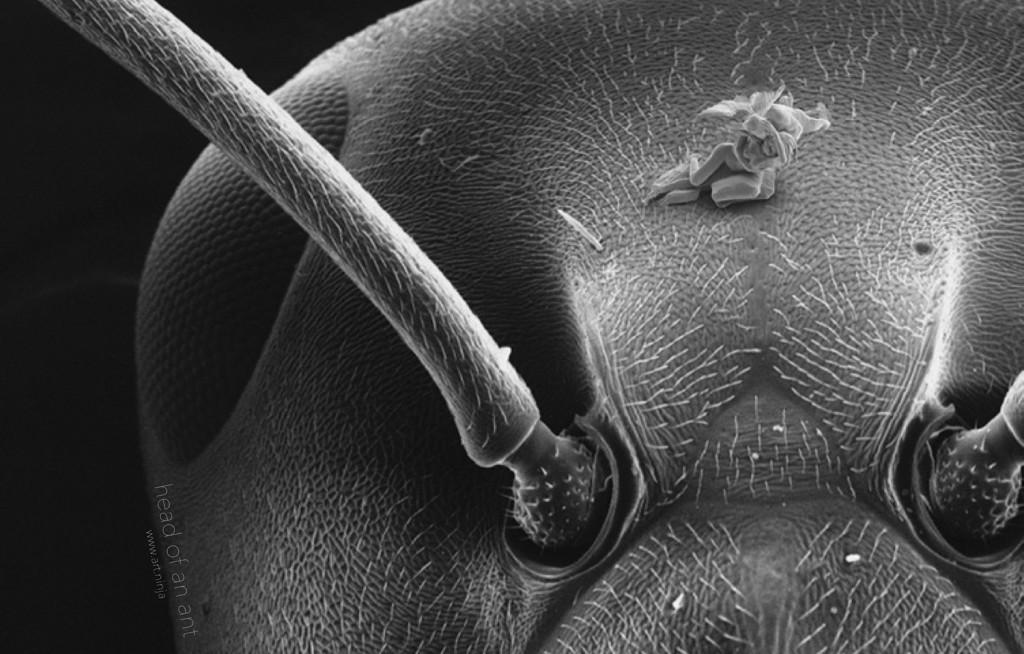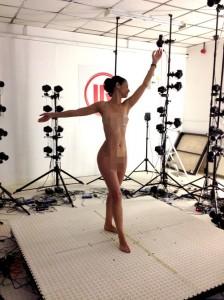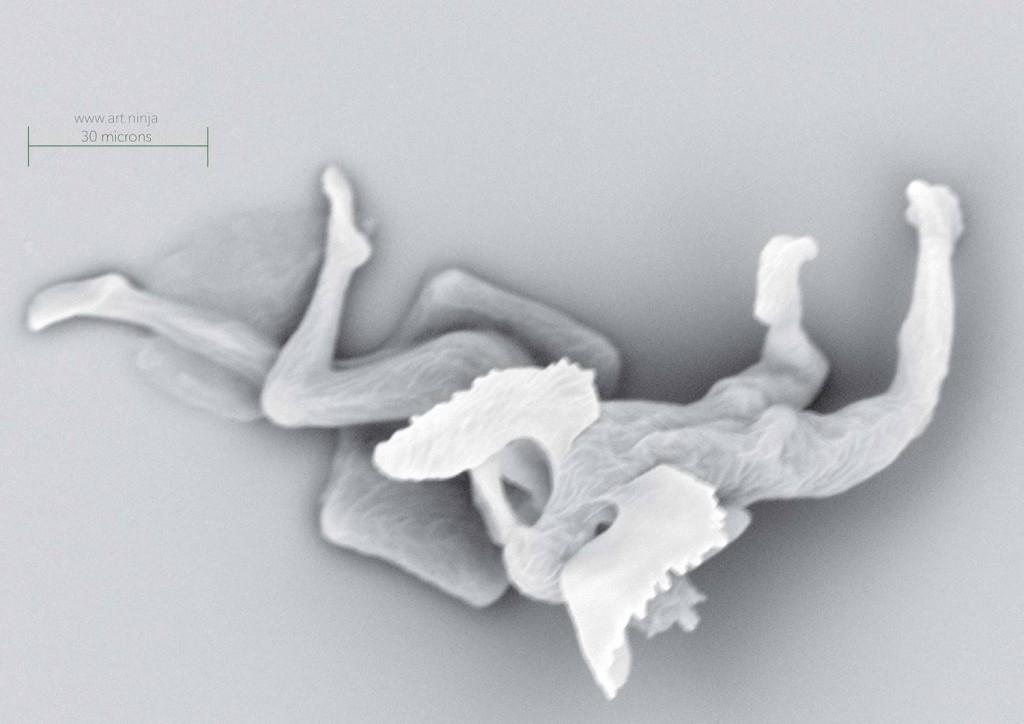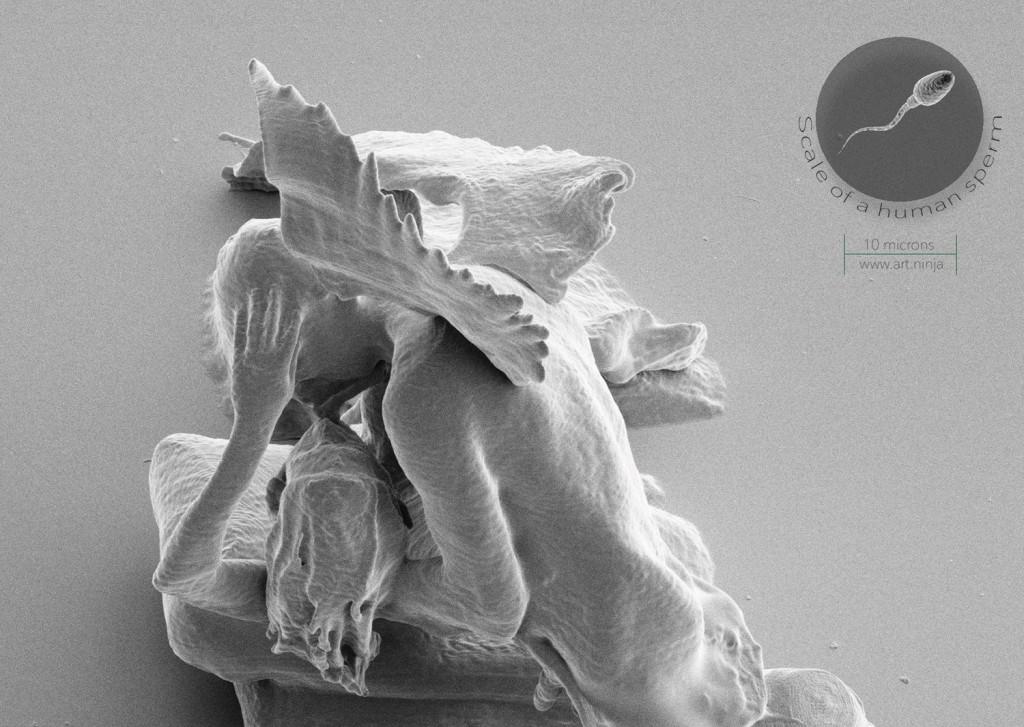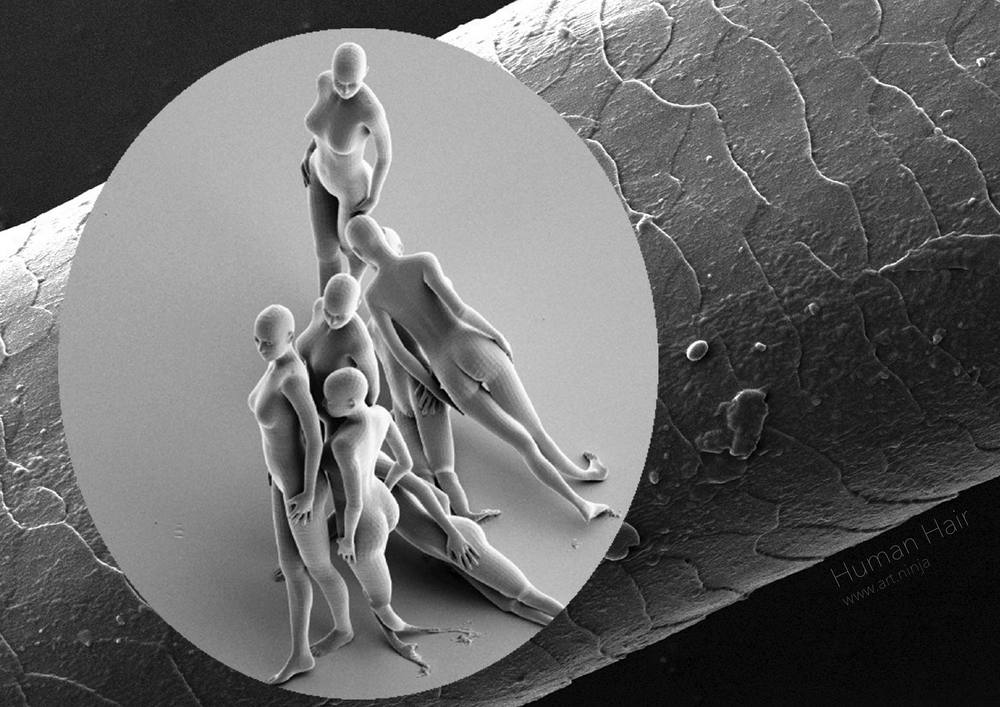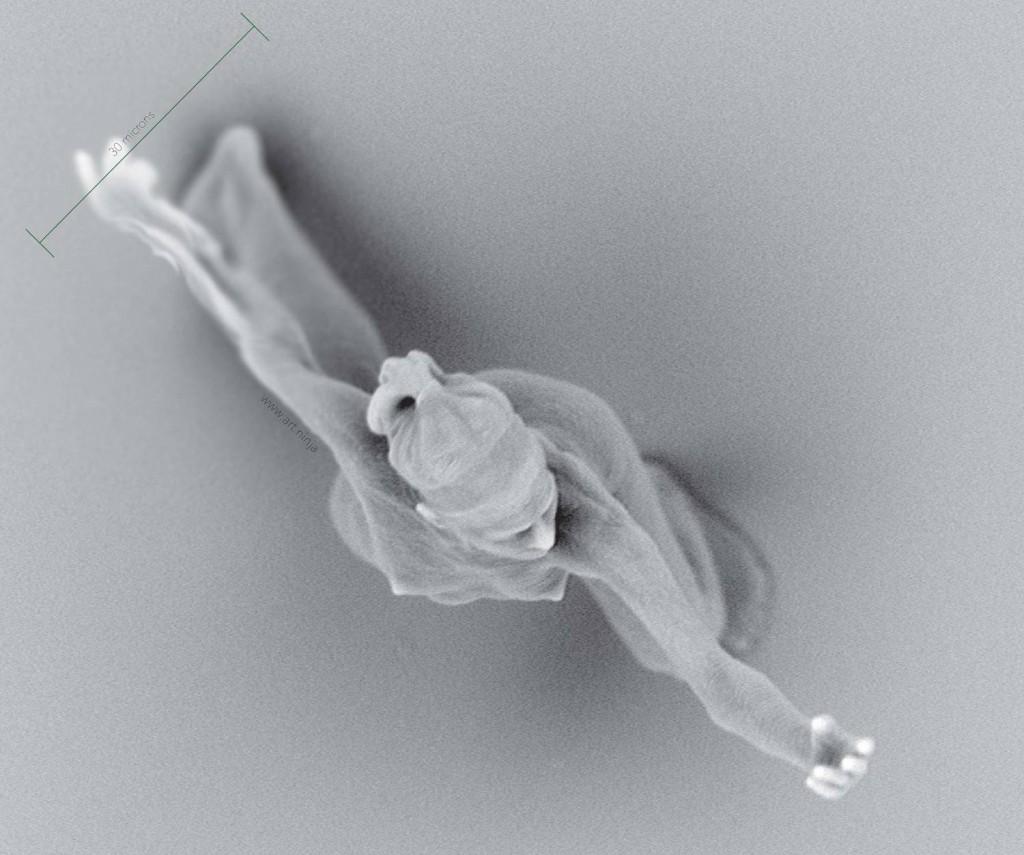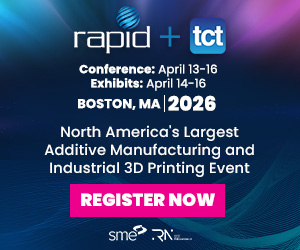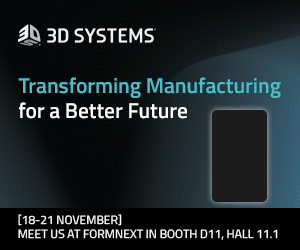“We live in an era where the impossible has finally come to pass. In our own little way we have become demi-gods of creation.” – Jonty Hurwitz
We’ve seen some absolutely amazing art over the past 6,000 years of human history, and, more recently, we’ve seen some incredible creations that were made using 3D printing and imaging techniques. But now it’s clear — some of the most impressive art is something we will never see. At least not with the naked eye. Or even a jeweler’s scope, or a microscope that can magnify 400x.
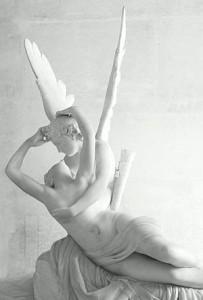
“Psyche Revived by Cupid’s Kiss” by Antonia Canova
Artist Jonty Hurwitz has created the world’s smallest sculptures: nanosculptures, created using a 3D printed photosensitive material, so small they can fit on the head of an ant, in the eye of a needle, on a human hair — so small they look like no more than a mote of dust hanging in a ray of sunlight. The largest of his sculptures — a series of seven, inspired by 18th century sculpture “Psyche Revived by Cupid’s Kiss” by Antonia Canova — is about the width of a human hair; the smallest is less than half that width.
“It’s so interesting when you bring in scientists — and I’ve had this happen in all the projects I’ve worked on –when you bring scientists into the art world, you get so inspired and so excited,” he says of the process.
Hurwitz enlisted a team of approximately 15 people to help him bring his vision to life. Beginning with scans of his models in a warehouse and ending in a laboratory looking through an electron microscope, he needed the assistance of an impressive collection of individuals to bring together art and science. The sculptures were printed — with advice from the Weizmann Institute of Science — using a 3D printing technique by the Institute of Microstructure Technology at the Karlsruhe Institute of Technology, with multiphoton lithography used for the fine detail work.
On his website, Hurwitz includes “A Note for the Geeks,” in which he addresses the science behind the nanosculptures:
“The structure is created using a ground-breaking new 3D printing technology and a technique called Multiphoton Lithography. Ultimately these works are created using the physical phenomenon of two photon absorption. Art, literally created with Quantum Physics.
If you illuminate a light-sensitive polymer with ultra violet wavelengths, it solidifies wherever it was irradiated in a kind of crude lump. Some of you may have experienced a polymer like this first hand at the dentist when your filling is glued in with a UV light.
If however you use longer wavelength intense light, and focus it tightly through a microscope, something wonderful happens: at the focus point, the polymer absorbs TWO PHOTONS and responds as if it had been illuminated by UV light, namely it will solidify. This two photon absorption occurs only at the tiny focal point – basically a tiny 3D pixel (called a Voxel). The sculpture is then moved along fractionally by a computer controlled process and the next pixel is created. Slowly, over hours and hours the entire sculpture is assembled pixel by pixel and layer by layer.”
Hurwitz also includes notes “for the Hippies” and “for the Poets,” as well as a section on “Myth vs Science.” All of these pieces come together in the nanosculptures, inspired by myth and brought into art by science.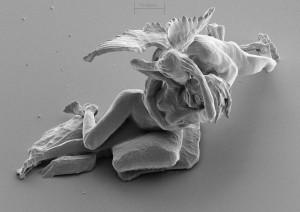
In a true tragedy reminding us of the fleeting nature of some human-created art, Hurwitz reveals that the nanosculptures have been lost. This does not, though, leave us high and dry, left to wonder; his artistic journey was so well documented that we are left with images (not as many, certainly, as anyone would have hoped) of the pieces and, above all, their story.
The way the story unfolds is told in a similar way to a Greek tragedy, really. From the start, where he fortuitously finds a warehouse space with Nikon cameras set up — over 200 of them — to capture his models, to unpacking the sculptures when he received them in the mail, everythingunfolds with almost a theatrical quality.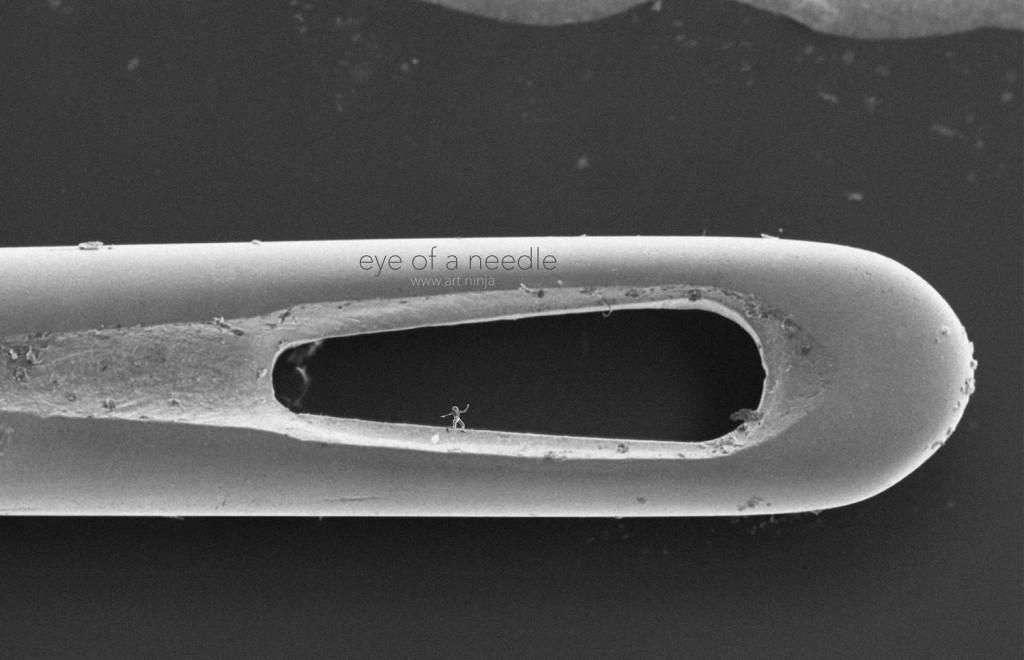
Packed in boxes “like a Russian doll,” layer upon layer of boxes and bubble wrap protecting the tiny jewelry box inside that held a mirror, Hurwitz was thrilled to open his creation. Opening that smallest box, though, he saw only the mirror: “There’s nothing on this mirror, and I’m like, ‘is this a scam?'” But then inspiration hit as he watched dust in a ray of sunlight: holding the mirror to the light, angling it this way and that, he noticed seven little specks, no different looking than the dust in the air… except that they were situated in an unnaturally straight line. The hunt was on for magnification that would let him see those specks, and after realizing the futility of a jeweler’s scope or a 400-magnification-power microscope, he found “Mr. G,” who had for over 30 years studied human cells, sperm, and cancer spells in an electron microscope, the only machine powerful enough to look at nanosculptures.
Mr. G told Hurwitz, “These are the most beautiful things I’ve ever seen,” and brought him in to see. It took them 45 minutes searching a small mirror with the electron microscope to find them: “and suddenly, you see a human form.” And they looked, and they looked, and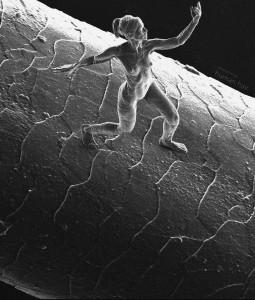 everything “just stops and everyone goes silent, and we stare at this, this feat of humanity, for minutes.” Wanting to get a better look at a different angle, Mr. G decided to move the mirror to better see the artistry.
everything “just stops and everyone goes silent, and we stare at this, this feat of humanity, for minutes.” Wanting to get a better look at a different angle, Mr. G decided to move the mirror to better see the artistry.
And that’s when they heard the “oops.” After another 45 minutes of, this time, fruitless searching on the mirror, they were unable to find the nanosculptures again. Hurwitz stopped the machine, removed the mirror from the vacuum it had been in to be scanned, and saw in the middle of the mirror, not a tiny straight line of dust-looking flecks, but a fingerprint. It was Mr. G’s fingerprint.
“I’ve just lost the absolute edge of what humanity is capable of, I’ve just lost these nanosculptures, they’re lost. And your first instinct when you lose something is to look, and you can’t see them… I’ve just lost, in my opinion anyway, seven of the most precious things ever made,” said Hurwitz in his video describing the project.
But then he saw the art behind the art, the story of the story.
“And suddenly the beauty of this story came to me, suddenly this story had taken on a life of its own, a narrative, which is always lacking with a sculpture… okay that’s great, the smallest sculpture in existence has been created, but what’s the story? …It’s created a story about human desire, a story about tragedy, a story about humor… I’ve told this story to people, they’ve fallen on the floor in hysterics.”
“A physical object went missing and in its place it’s left a story.”
What do you think of these nanosculptures? Have you heard other similar uses of 3D printing? Let us know your thoughts on the multiphoton lithography process, and the use of voxels in the 3D Printed Nanosculptures forum thread at 3DPB.com.
If you have 20 minutes, I absolutely recommend watching the video of Hurwitz explaining his project. There’s nothing quite like hearing from the artist himself how this story unfolded.
Subscribe to Our Email Newsletter
Stay up-to-date on all the latest news from the 3D printing industry and receive information and offers from third party vendors.
Print Services
Upload your 3D Models and get them printed quickly and efficiently.
You May Also Like
Axtra3D Brings Full “Axtra Workflow” and New Materials to Formnext 2025
Axtra3D hits Formnext 2025 with a big shift in strategy. The company isn’t just selling printers anymore; it’s selling a complete workflow. At the show, Axtra3D unveiled its new Axtra...
From Hobby to Hustle: How the Prosumer 3D Printing Market Is Rewriting the Industry
When many hear 3D printing, they still think of hobbyists tinkering in garages, making figurines, models, or toys. But that image has changed. A new wave of users exists between...
Bambu Lab Launches P2S: Expanding the P1 Legacy with Smarter, Faster Printing
See the addendum to this article for an update from 11/25/2025. Just two years after shaking up desktop 3D printing with the P1 Series, Bambu Lab is back with the...
Trust Bambu
Bambu Lab‘s relentless rise has galvanized the industry into a furious response, making desktop 3D printers much faster and more reliable. Other competitors are in denial and, like deer in...


